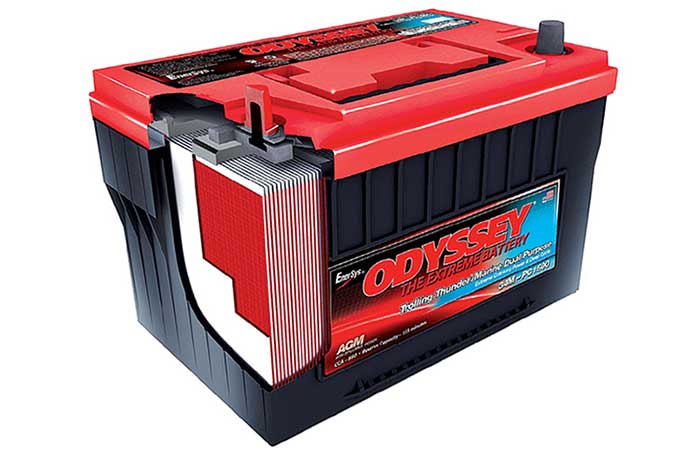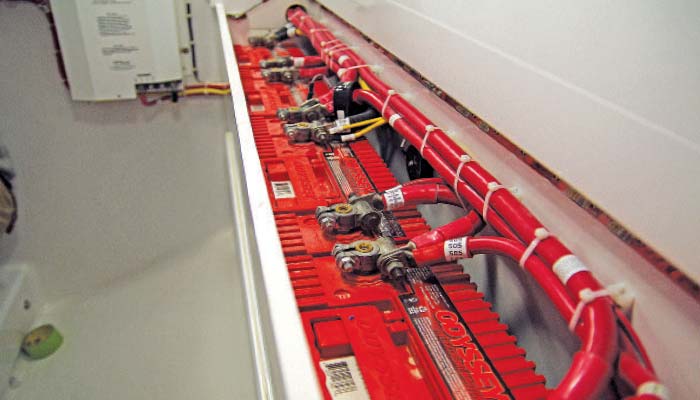Advertisement
Smart tips for understanding your battery and maximizing its cycle life — and your return on investment.

If ever there was an area of boat maintenance shrouded in mystery and old wives' tales, it's got to be how to properly care for marine batteries. Just talk to your dock mates about batteries, how to make them last, and what's good or bad, and you'll get five different opinions from five different people. Having just purchased a new pair of batteries for my own boat, I've recently felt the financial pain associated with battery replacement. So, maximizing what we refer to as "cycle life" — the number of times you can discharge the battery to some specified level — is increasingly important to make sure you're getting your hard-earned money's worth.
Battery Categories
Each battery category has its place, and maximizing potential cycle life is in part dependent upon what you need the battery to be able to do best.
Tip
Deep-cycle Batteries
Deep-cycle batteries are designed to provide a nearly continuous amount of current for an extended period of time and to be recharged many times over.
Cranking Batteries
Cranking batteries are designed to provide a burst of high current (cranking amps) for a very brief period of time, basically long enough to get your engine started. These batteries are a poor choice for deep-cycle applications.
Combination Batteries
Combination batteries are simply a compromise category that provides adequate cranking amperage to get engines started, yet can deliver moderate amounts of continuous current for an extended period of time but not as long as a true deep-cycle battery. Each of these can be made using differing battery technologies, which differ by how the electrolyte is contained.
Most cruiser-style boats will have a combination of cranking and deep-cycle batteries. Often the deep-cycle battery bank will be made up of multiple batteries to supply power for extended periods away from the dock, but the boat may have only one dedicated cranking battery to get the engine started. Another common configuration today is to use deep-cycle batteries for everything on modern cruisers. This approach can work fine as long as the CCA (cold cranking amps at 0 degrees) or MCA (marine cranking amps at 32 degrees) rating for the battery matches the requirements of the engine. This is easily accomplished today because modern starter motors draw far less electrical current than their historic counterparts. For my own boat, which is a center console that we use extensively for fishing, we use a pair of combination or dual-purpose batteries that work just fine for frequent starting and shutting down as we move from one hot spot to another, and for the occasional anchored-in-place application with the stereo, instruments, and lighting drawing power.
Important Terms
To understand the important maintenance procedures required to maximize cycle life, there are a few terms you need to be clear on: electrolyte, sulfation, and equalization.
Electrolyte is the solution through which the ions move that give the battery its electrical potential. Depending on the specific battery technology you use — flooded cell (either sealed or not sealed), absorbed glass mat (AGM), or gel cell — the electrolyte will be in a liquid format or immobilized. For lead-acid batteries, we're talking about a mix of distilled water and sulfuric acid. AGM batteries have the liquid saturated into matting that is squeezed between the plates inside each cell of the battery, effectively immobilizing the electrolyte. Gel batteries use a mix of sulfuric acid, water, and a thick silica gel to immobilize the electrolyte. Gels are particularly sensitive to recharge regimens, as overcharging can force gas bubbles to form in the gel and pull the active electrolyte away from the plate material. Conversely, modern AGM batteries seem to be relatively forgiving as to charge rate and can take a faster, higher rate of charge than any of the lead-acid technologies.

Sulfation is the most common cause of short battery life in deep-cycle batteries. It occurs when a lead-acid battery is not allowed to get up to full charge, which means the sulfates that accumulate on the lead plates in the battery don't fully return to the sulfuric acid solution but instead remain on the plate. There are actually two types of sulfation we need to worry about: reversible or soft sulfation; and permanent, hard sulfation. The equalization phase provided with some battery chargers can act to reverse soft sulfation. But if the battery is left in a discharged state for extended periods of time, the lead sulfate particles convert themselves to crystalline particles that grow in size over time and attach themselves to the negative plates in a battery cell. As these sulfate crystals accumulate on the plates, the effective surface area of the plate is reduced, lowering the amount of lead exposed to the electrolyte and reducing the capacity of the battery. Leaving lead-acid batteries in a partial or low state of charge for extended periods of time invites early and profound hard sulfation — and sure death for your batteries.
Equalization is a term used to describe a controlled overcharge of a deep-cycle battery that can reverse the sulfation process and dissolve the sulfate crystals, getting them back into suspension within the liquid electrolyte. The "equal" part of the word describes what happens among the cells of the battery after successful equalization: Their individual voltage levels and electrolyte specific gravity levels become evenly balanced. (Equalization cycles should not be employed on AGM or gel-cell batteries, as irreparable damage to the battery can occur.) The reaction inside the battery is quite violent during this phase, and battery-plate damage can occur if this is done too frequently or excessively high voltages are applied. Check with the battery manufacturer to determine how often deep-cycle batteries need to be equalized.
Maximizing Cycle Life
To begin, you need to understand that the different battery technologies mentioned here — flooded, sealed-flooded, AGM, and gel — all have different needs regarding recharging. These seemingly minute (tenths of a volt) variations in recharging profiles as well as time differences for charging are key to maximizing the life of your batteries. Additionally, the level of discharge that you regularly bring your batteries to will make a significant difference. These discharge levels vary from one manufacturer to another and among battery types. Traditionally, 50 percent of battery capacity in amp hours is the maximum level of discharge for flooded lead-acid batteries to achieve maximum cycle life. With modern AGM and thin plate pure lead (TPPL) batteries (TPPL batteries are versions of AGM batteries), vendors will throw out numbers like 60 percent to 80 percent of discharge as being totally acceptable. This increases the amp hours you can actually get from a given battery by as much as 30 percent. That's an important consideration because of the limited amount of space on board to store batteries. Weight is also a factor; the idea here is more amp hours per pound.
One of the most important things you can do to maximize battery life is to install adequate capacity to meet your needs, without exceeding the optimal discharge level of the batteries.
If you're using flooded-cell batteries with removable cell caps, check the electrolyte level monthly, and top up the batteries with distilled water as needed. On any battery, make sure cable connections are tight and clean and free of corrosion. Once cleaned, a coating of corrosion inhibitor like Boeshield T-9 is a big help. This bit of maintenance ensures that you'll get the most amp hours out of the battery for powering up your boat, and that the most amp hours will get back into the battery when connected to a charger.
Once all the above has been accomplished, the bottom line for extending battery life boils down to proper battery-charging regimens tailored to the battery type and size. The last 10 years have seen marine battery-charger technology improve dramatically. State-of-the-art units can be programmed for up to three different onboard battery types, and some provide an intermediate fourth phase (most have three) of charging called "pre-float" to better transition the battery from what's called the absorption phase to the float phase, to maintain a 100-percent charge level while automatically adjusting voltage to ensure no overcharging. A good one will come with a temperature sensor for mounting on the battery for a more precisely controlled output based on battery temperature, a highly recommended feature. Recommended battery chargers are available from Blue Sea, Charles Industries, ProMariner, Mastervolt, and Newmar.
What To Look For In A Battery Charger
- Proper amperage rating for the battery bank in amp hours you're going to recharge. Output should be 25 percent to 40 percent of the battery-bank capacity in amp-hours. For example, if you have two 100-amp hour batteries (200 total amp-hours), select a charger with an output of 50 to 80 amps.
- Temperature sensing for automatic adjustment of charger output in real time.
- Programmability of the charger to tenths of a volt for the various phases of charge provided.
- Battery-type selection. Flooded, AGM, gel, and TPPL, etc. Equalization phase for use with flooded-cell batteries, either programmable or manually selectable.
- Rated for ignition protection if going to be installed in a gasoline engine room.
- Multiple voltage and frequency input capability, if using in an international cruising environment.
